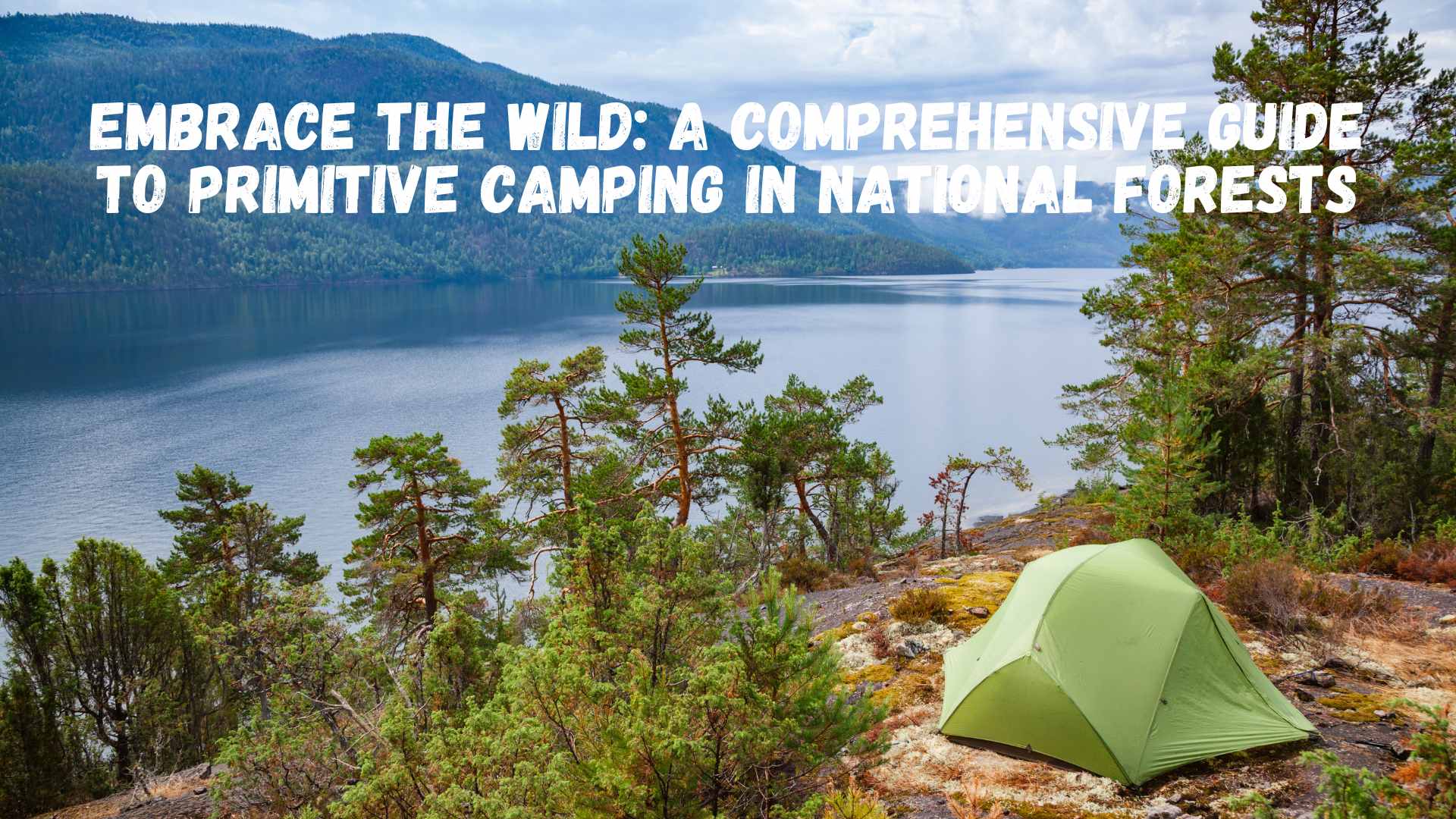Primitive camping, also known as dispersed camping, offers a unique opportunity to immerse yourself in nature, away from the amenities and crowds of designated campgrounds. With nothing but your gear and the great outdoors, you can experience true solitude and self-sufficiency. This guide will equip you with everything you need to know to enjoy a safe and unforgettable primitive camping adventure in national forests.
What is Primitive Camping?
Primitive camping means setting up camp outside of designated areas, often in remote and undeveloped locations. It’s all about self-reliance, as you won’t find amenities like restrooms, running water, or fire pits. The trade-off? An authentic wilderness experience, complete with tranquility, stunning landscapes, and a deep connection with nature.
Planning Your Trip
Proper planning is crucial for a successful primitive camping trip. Here’s how to prepare:
- Research Regulations: Each national forest has specific rules regarding dispersed camping. Check with the local ranger station or the U.S. Forest Service website for information on permits, camping zones, and fire restrictions.
- Choose Your Destination: Consider factors such as distance, terrain, weather, and wildlife. Popular national forests for primitive camping include Pisgah National Forest (NC), White River National Forest (CO), and Gifford Pinchot National Forest (WA).
- Inform Others: Always let someone know your itinerary, including your expected return date and location.
Choosing Your Campsite
Finding the perfect spot for your primitive campsite requires some scouting and consideration:
- Legal and Ethical Considerations: Camp at least 200 feet away from water sources to protect riparian areas and wildlife. Avoid private property and respect no-camping signs.
- Terrain and Shelter: Look for flat, durable surfaces like sand, gravel, or dry grass. Avoid low-lying areas prone to flooding and sites under dead trees (widowmakers).
- Environmental Impact: Choose a previously impacted site to minimize your footprint. If you must create a new site, disturb as little as possible and restore the area before leaving.
What to Pack
Packing the right gear is essential for comfort and safety:
- Shelter and Sleeping Gear: Bring a sturdy tent, a weather-appropriate sleeping bag, and a sleeping pad for insulation and comfort.
- Water and Filtration: Carry at least one gallon of water per person per day. Bring a portable water filter or purification tablets for refilling from natural sources.
- Food and Cooking Supplies: Pack lightweight, non-perishable foods. A portable stove and cookware are necessary for preparing meals.
- Clothing: Dress in layers to adapt to changing weather. Include a waterproof jacket, warm layers, and sturdy hiking boots.
- Navigation Tools: A map, compass, and GPS device are essential. Don’t rely solely on your phone’s GPS, as signal can be unreliable.
- First Aid Kit: A comprehensive first aid kit should include bandages, antiseptics, pain relievers, and any personal medications.
- Leave No Trace Supplies: Bring trash bags, a trowel for digging catholes, and biodegradable soap.
Setting Up Camp
Setting up a comfortable and environmentally friendly camp is key to a great experience:
- Shelter: Pitch your tent on a durable, flat surface. Secure it well to withstand wind and weather.
- Cooking Area: Set up a cooking area away from your sleeping area to avoid attracting wildlife. Use a portable stove instead of an open fire whenever possible.
- Fire Management: If fires are allowed, use a fire pan or build a mound fire to minimize ground impact. Always keep fires small, never leave them unattended, and ensure they’re completely extinguished before leaving.
- Sanitation: Use a trowel to dig a cathole 6-8 inches deep for human waste, at least 200 feet from water sources, trails, and camp. Pack out all used toilet paper and hygiene products.
Safety Tips
Safety is paramount in remote and wild environments:
- Wildlife Awareness: Store food in bear-proof containers or hang it from a tree at least 10 feet off the ground and 4 feet from the trunk. Avoid leaving food scraps or scented items unattended.
- Weather Preparedness: Check the weather forecast before your trip and be prepared for sudden changes. Pack extra clothing and emergency shelter.
- Hydration and Nutrition: Stay hydrated and consume enough calories to maintain energy levels. Dehydration and hunger can quickly lead to fatigue and poor decision-making.
- Emergency Plan: Have an emergency plan in place. Know the nearest emergency contact point and carry a whistle or signaling device.
Leave No Trace Principles
Primitive camping demands a strong commitment to Leave No Trace principles to protect natural environments:
- Plan Ahead and Prepare: Know the regulations and special concerns for the area you visit.
- Travel and Camp on Durable Surfaces: Stick to established trails and campsites. Avoid trampling vegetation.
- Dispose of Waste Properly: Pack it in, pack it out. Carry all trash and leftover food out with you.
- Leave What You Find: Preserve the past; leave rocks, plants, and other natural objects as you find them.
- Minimize Campfire Impact: Use a stove for cooking and enjoy a candle lantern instead of a campfire if possible.
- Respect Wildlife: Observe wildlife from a distance. Never feed animals or leave food out.
- Be Considerate of Other Visitors: Respect others and protect the quality of their experience. Keep noise to a minimum and camp away from trails and other campers.
Exploring and Enjoying Your Surroundings
Primitive camping allows for endless exploration and connection with nature:
- Hiking and Exploration: Use your campsite as a base to explore nearby trails, peaks, and scenic spots. Always carry a daypack with essentials like water, snacks, a map, and a first aid kit.
- Wildlife Watching: Early mornings and late evenings are the best times for wildlife viewing. Bring binoculars and a field guide to enhance your experience.
- Stargazing: Far from city lights, national forests offer incredible stargazing opportunities. Lie back and enjoy the night sky, identifying constellations and shooting stars.
Packing Up and Heading Home
Leaving your campsite better than you found it ensures the wilderness remains pristine for future visitors:
- Clean Up: Thoroughly inspect your campsite for trash and debris. Pack out all waste, including food scraps and hygiene products.
- Restore the Site: Naturalize the area by dispersing any fire rings, scattering unused rocks, and brushing out footprints.
- Reflect on Your Experience: Take a moment to reflect on your adventure, the beauty you’ve witnessed, and the solitude you’ve enjoyed.
Final Thoughts
Primitive camping in national forests offers a unique blend of adventure, tranquility, and a deep connection to nature. By planning carefully, respecting the environment, and embracing the simplicity of the wild, you can create unforgettable memories and experience the outdoors in its purest form. So pack your gear, leave the crowds behind, and embark on a journey to rediscover the natural world.
Follow Our Adventures
Stay connected with Outdoor Crusade for more tips, adventures, and outdoor inspiration:




